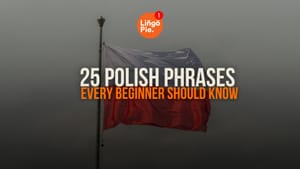Greetings are one of the easiest ways to start speaking a new language, and in Polish, they carry a lot of meaning. A simple “Cześć” or “Dzień dobry” can show respect, break the ice, and make interactions feel more genuine. Knowing the right phrases for hello and goodbye helps you feel more confident when meeting Polish speakers in any setting.
In this post, we'll cover essential greetings, how to use them naturally, and the small customs that make Polish communication feel warm and welcoming. Let's learn Polish, shall we?
- 13 Must-Know Polish Traditions For Your Next Trip
- How to Improve Your Polish Conversation Skills [5 Tips]
- Is Polish Hard To Learn? [Insights + Best Tips]

Where Is Polish Spoken?
Polish is the official language of Poland, spoken by over 35 million native speakers as of 2024. But its reach extends far beyond the country’s borders. Polish communities thrive across the globe, making it one of the most widely spoken Slavic languages.
Polish is often used as a second language in parts of Germany, the Czech Republic, Slovakia, Belarus, Ukraine, Lithuania, and Latvia. Large Polish diasporas also speak it in countries like the United States, Canada, the United Kingdom, Australia, Brazil, Argentina, Israel, and Russia.
With such a global presence, learning even the basics (especially common greetings) can be incredibly valuable. Whether you're traveling, meeting Polish speakers in your city, or watching Polish TV shows, knowing how to say “hello” or “goodbye” helps you make a strong first impression and connect across cultures.

Formal Polish Greetings
Let's start with the essential greetings that'll get you through most situations.
Dzień dobry (jen DOH-bree)
This is your go-to formal greeting meaning "good day." You'll use this from morning until early evening in professional settings, with people you don't know well, or when showing respect to elders. It's like having a reliable suit—appropriate for almost any formal occasion.
- Dzień dobry, czy mogę państwu pomóc? - Good day, can I help you?
- Dzień dobry! Miło pana poznać. - Good day! Nice to meet you.
Dobry wieczór (DOH-bree VYE-choor)
When the sun starts setting, switch to "good evening." This maintains the same level of formality as dzień dobry but shows you're culturally aware of the time. Perfect for evening business meetings or formal dinner parties.
- Dobry wieczór, dziękuję za zaproszenie. - Good evening, thank you for the invitation.
- Dobry wieczór państwu! - Good evening to you all!
Cześć (chesh-ch)
Here's the greeting you'll hear most often among friends, family, and peers. It means both "hello" and "goodbye"—think of it as Polish multitasking. The pronunciation might be tricky at first, but it's worth mastering since you'll use it constantly in casual situations.
- Cześć! Jak się masz? - Hi! How are you?
- Cześć, do zobaczenia jutro. - Hi, see you tomorrow.
Witam (VEE-tahm)
This greeting literally means "I welcome you" and strikes a middle ground between formal and casual. You'll often see it in professional emails or when greeting customers, making it perfect for business contexts where you want to be polite but not overly stiff.
- Witam serdecznie na naszej stronie. - I warmly welcome you to our website.
- Witam, czy mogę pomóc? - Greetings, can I help?

Cool Polish Greetings
Want to sound like you belong with younger Polish speakers? These slang greetings will make you sound natural and contemporary—just save them for informal situations with friends.
Siema (SHEH-mah)
This casual greeting is a contraction of "jak się masz?" (how are you?) and has become the go-to among young Poles. It's energetic and friendly, perfect for greeting friends or people your age in relaxed settings.
- Siema! Co słychać? - What's up! What's new?
- Siema, idziemy na kawę? - Hey, want to go for coffee?
Siemanko (sheh-MAHN-koh)
Take "siema" and add a cute ending—that's "siemanko." It's more playful and endearing, great for close friends or when you want to sound especially warm and friendly.
- Siemanko! Gotowy na imprezę? - Hey there! Ready for the party?
Hej (hey)
Borrowed from English, this greeting feels familiar but with a Polish twist. Younger people use it frequently, and it's perfect when you want something casual but not as distinctly Polish as "siema."
- Hej! Świetnie cię widzieć! - Hey! Great to see you!
Elo (EH-loh)
This ultra-casual greeting comes from English slang and you'll hear it among teenagers and young adults. It's very informal, so use it only with close friends or peers in very relaxed settings.
- Elo, co robisz? - Yo, what are you doing?

Polish Expressions That Also Work as Greetings
These aren’t greetings in the strict sense, but they’re commonly used to start conversations, especially in informal Polish.
Jak się masz?
Jak się masz? means "How are you?" in Polish. It’s a fairly direct phrase that appears more often in written or formal contexts than in everyday speech. It’s best used after an initial greeting or when reconnecting with someone you haven’t seen in a while.
- Cześć, jak się masz? – Hi, how are you?
- Jak się masz, Agnieszka? – How are you, Agnieszka?
Co słychać?
Co słychać? means "What’s new?" or "How’s it going?" It’s a very common and friendly way to ask how someone is doing in Polish. This expression is perfect for informal check-ins with friends, family, or colleagues you’re familiar with.
- Hej, co słychać? – Hey, what’s new?
- Co słychać u ciebie? – How are things with you?
Elo / Joł
Elo or Joł means "Yo" in Polish. These are slangy, casual greetings mostly used by teenagers or within pop culture. They're best suited for social chats, messages, or playful, informal exchanges.
- Elo, mordeczko! – Yo, buddy!
- Joł, co u ciebie? – Yo, how are you?
Serdeczne pozdrowienia (for writing)
Serdeczne pozdrowienia means "Warm greetings" in Polish. It’s typically used in letters or formal emails to express kindness and warmth. This phrase is best for politely opening or closing a written message, especially in professional or respectful contexts.
- Serdeczne pozdrowienia z Krakowa! – Warm greetings from Kraków.
- Pozdrowienia dla całej rodziny. – Greetings to the whole family.

How To Greet Someone In Poland
Polish greetings reflect a culture that values respect, formality, and social context. While Polish people are warm and friendly, their greeting customs depend heavily on factors like age, setting, and how well you know someone. Understanding how and when to use the right greeting can help you avoid awkward moments and connect more naturally with locals.
Formality Matters
Poles are generally more formal than in many Western cultures, especially when meeting someone for the first time. Use "Dzień dobry" (Good day) or "Dobry wieczór" (Good evening) when greeting strangers, elders, or professionals. Save "Cześć" (Hi) and "Siema" (Hey) for friends, peers, or informal settings.
Physical Greetings
Handshakes are the standard form of greeting in Poland. They are firm, brief, and almost always accompanied by eye contact and a verbal greeting. In more formal situations, men often wait for a woman to offer her hand first.
Among friends or family, greetings might include a hug or even a kiss on the cheek (usually once, and mostly among women or between close female-male friends). Men rarely kiss as a greeting unless with family.
When Entering a Room or Shop
It’s polite and expected to greet people when entering a room, office, or store, even if you don’t know them. A simple "Dzień dobry" goes a long way in showing respect and acknowledging others' presence.
Greeting in Group Settings
When walking into a room with multiple people, it’s common to greet the entire group with a single "Dzień dobry Państwu" (Good day to you all) or simply "Witam wszystkich" (Hello everyone). Poles appreciate this small gesture of politeness, especially in professional or social gatherings.
Departing Politely
Just like greetings, how you say goodbye matters. Use "Do widzenia" in formal settings and "Pa" or "Na razie" in casual conversations. Even if you’re in a rush, ending a conversation with a polite goodbye is expected.
Learn Polish With Lingopie
Once you’re familiar with the basics, the best way to build confidence is by hearing the language in real situations. Lingopie makes that easy by giving you access to authentic Polish TV shows and films, complete with interactive subtitles that support learning while you watch.
You’ll hear how native speakers greet each other, pick up everyday phrases in context, and start to understand how Polish sounds in real life. It’s a fun, relaxed way to learn, and a great next step if you want to speak more like a local. Give Lingopie a try now!




![How To Say Love In Different Languages [120+ Ways]](/blog/content/images/2024/11/How-To-Say-Love-In-Different-Languages--120--Ways-.jpg)



![5 Best Apps To Learn Polish As A Beginner [2025]](/blog/content/images/size/w300/2025/08/best-apps-to-Learn-Polish.jpg)
![What’s The Best Way To Learn Polish Quickly? [Guide]](/blog/content/images/size/w300/2025/08/What-s-The-Best-Way-To-Learn-Polish-Quickly.jpg)